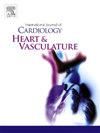Protective effect of high-density lipoprotein in infective endocarditis patients after valve surgery
IF 2.5
Q2 CARDIAC & CARDIOVASCULAR SYSTEMS
引用次数: 0
Abstract
INTRODUCTION
Lipoproteins and insulin resistance are associated with the prognosis of cardiovascular disease, with strong evidence supporting a causal relationship for some; however, whether lipoproteins and insulin resistance have prognostic value in patients with infective endocarditis after valve surgery remains unclear.
METHODS
We included 278 consecutive patients with a definite diagnosis of IE who underwent valve surgery from January 2010 to December 2022. Mortality was analyzed in relation to lipid profile and insulin resistance. Patients were divided into a higher high-density lipoprotein (>0.905 mmol/L) group and a lower high-density lipoprotein (≤0.905 mmol/L) group based on the cutoff value of the high-density lipoprotein. A Kaplan–Meier survival analysis was conducted for patients in two groups. Subgroup analysis and restricted cubic splines regression of the association between baseline high-density lipoprotein and incident all-cause mortality were performed.
RESULTS
Among 278 patients (mean age 44.96 years, 28.1 % female), there were 36 all-cause mortalities during a median 60.98 months follow-up. Kaplan–Meier survival analysis showed lower 12-year mortality in patients with high-density lipoprotein levels > 0.905 mmol/L (HR = 0.125, p < 0.001). There were no significant interactions in any of the subgroups. The adverse effect of high-density lipoprotein on all-cause mortality was consistent after adjusting for the confounders across all subgroups. The restricted cubic splines regression model revealed a linear association between high-density lipoprotein and the risk of all-cause mortality (p for nonlinearity = 0.477), and this linear association is more pronounced in women.
CONCLUSION
High-density lipoprotein levels are associated with lower mortality in infective endocarditis patients after valve surgery, particularly in female patients.
高密度脂蛋白在感染性心内膜炎瓣膜术后的保护作用
脂蛋白和胰岛素抵抗与心血管疾病的预后相关,有强有力的证据支持两者之间存在因果关系;然而,脂蛋白和胰岛素抵抗对瓣膜手术后感染性心内膜炎患者是否有预后价值尚不清楚。方法:我们纳入了2010年1月至2022年12月期间接受瓣膜手术的278例明确诊断为IE的连续患者。分析死亡率与血脂和胰岛素抵抗的关系。根据高密度脂蛋白的临界值将患者分为高密度脂蛋白高组(>0.905 mmol/L)和高密度脂蛋白低组(≤0.905 mmol/L)。对两组患者进行Kaplan-Meier生存分析。对基线高密度脂蛋白与事件全因死亡率之间的关系进行亚组分析和限制性三次样条回归。结果278例患者(平均年龄44.96岁,女性28.1%)中位随访60.98个月,全因死亡36例。Kaplan-Meier生存分析显示高密度脂蛋白水平患者的12年死亡率较低。0.905 mmol/L (HR = 0.125, p <;0.001)。在任何一个亚组中都没有明显的相互作用。在所有亚组中调整混杂因素后,高密度脂蛋白对全因死亡率的不利影响是一致的。限制三次样条回归模型显示高密度脂蛋白与全因死亡风险之间存在线性关联(非线性p = 0.477),且这种线性关联在女性中更为明显。结论:高密度脂蛋白水平与瓣膜手术后感染性心内膜炎患者(尤其是女性患者)较低的死亡率相关。
本文章由计算机程序翻译,如有差异,请以英文原文为准。
求助全文
约1分钟内获得全文
求助全文
来源期刊

IJC Heart and Vasculature
Medicine-Cardiology and Cardiovascular Medicine
CiteScore
4.90
自引率
10.30%
发文量
216
审稿时长
56 days
期刊介绍:
IJC Heart & Vasculature is an online-only, open-access journal dedicated to publishing original articles and reviews (also Editorials and Letters to the Editor) which report on structural and functional cardiovascular pathology, with an emphasis on imaging and disease pathophysiology. Articles must be authentic, educational, clinically relevant, and original in their content and scientific approach. IJC Heart & Vasculature requires the highest standards of scientific integrity in order to promote reliable, reproducible and verifiable research findings. All authors are advised to consult the Principles of Ethical Publishing in the International Journal of Cardiology before submitting a manuscript. Submission of a manuscript to this journal gives the publisher the right to publish that paper if it is accepted. Manuscripts may be edited to improve clarity and expression.
 求助内容:
求助内容: 应助结果提醒方式:
应助结果提醒方式:


